Translate this page into:
Prevalence of skin diseases among Omani population attending dermatology clinics in North Batinah Governorate, Oman – retrospective study of 2,32,362 cases
Correspondence Address:
Pramod Kumar
Saham Hospital, P.O. Box - 582, P. C. – 319
Oman
| How to cite this article: Kumar P. Prevalence of skin diseases among Omani population attending dermatology clinics in North Batinah Governorate, Oman – retrospective study of 2,32,362 cases. Indian J Dermatol Venereol Leprol 2019;85:440 |
Sir,
After prior approval from regional research and ethics approval committee, we conducted a retrospective analysis of the data of all patients attending 5 dermatology clinics in North Batinah Governorate of Oman, i.e. Sohar, Saham, Shinas, Khabura and Suwaiq for 4 years from 01/01/2010 to 31/12/2013. Data was grouped on the basis of etiological diagnoses and a comparison was done with previous studies available in the region and other parts of the world.
During the study period, 232362 patients sought dermatology consultation, as depicted in [Table - 1]. Age of the subjects ranged from the 2 days to 90 years and the gender distribution is as shown in [Table - 2], with a female predominance. Majority (45%) of the cases belonged to the age group 15 to 35 years; at the same time, children less than 5 years of age formed a sizeable 16.66% of the study population.
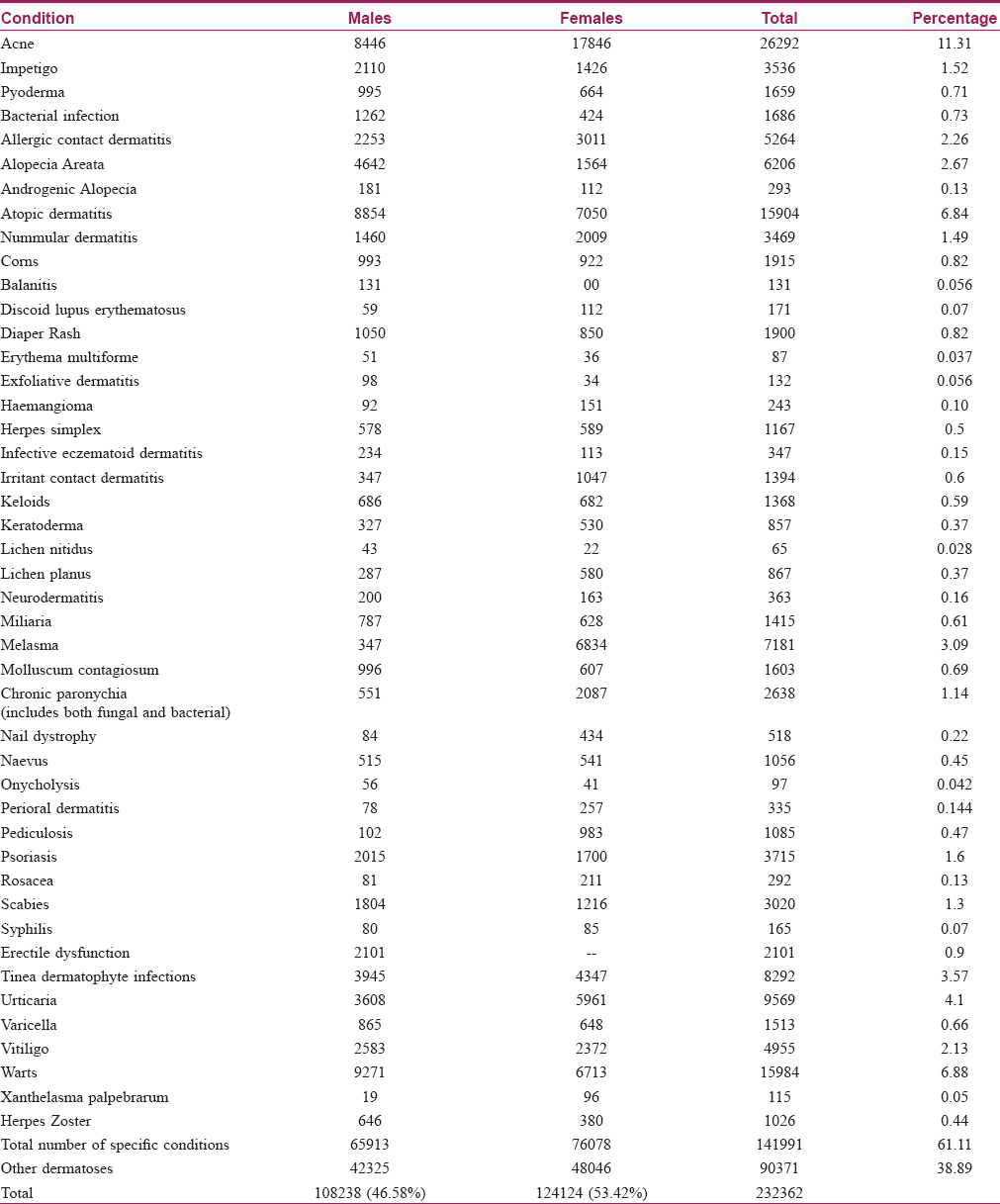

Non-infectious conditions topped the list accounting for 34.60% (n = 80398) of the etiological diagnoses, whereas infectious conditions amounted to 23.64 percent (n = 54929) as shown in [Table - 3] and [Figure - 1] respectively.
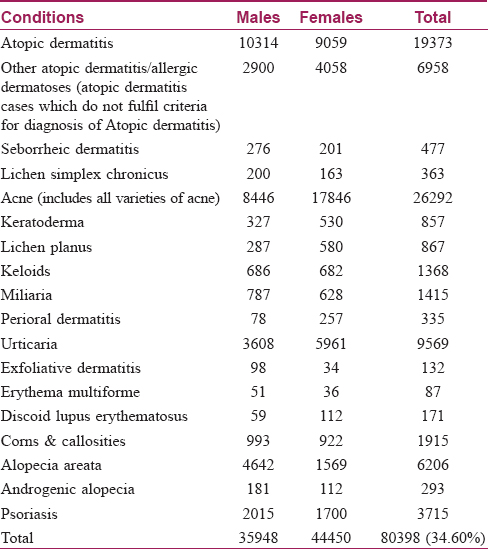
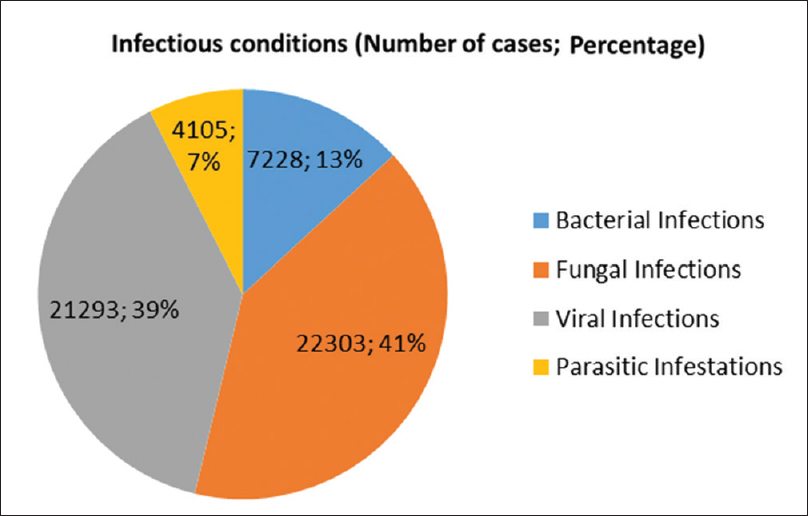 |
| Figure 1: Infectious Disorders |
Acne (11.31%, n = 26292) was the single largest condition followed by viral warts (6.88%, n = 15984). Amongst the non-infectious disorders, acne accounted for the largest share (11.31%, n = 26292) followed by atopic dermatitis (8.34%, n = 19373), further followed by urticaria (4.1%, n = 9569).
[Table - 4] shows fungal, viral, bacterial infections and also disorders affecting hair.

[Figure - 2] shows the details of various fungal infections in this study. Chronic paronychia was the leading cause (79.53% of nail disorders, n = 2638) nail dystrophy (6.87% of nail conditions, n = 228) and acute paronychia (5.37% of nail conditions, n = 178) were the other important conditions, as shown in [Figure - 3].
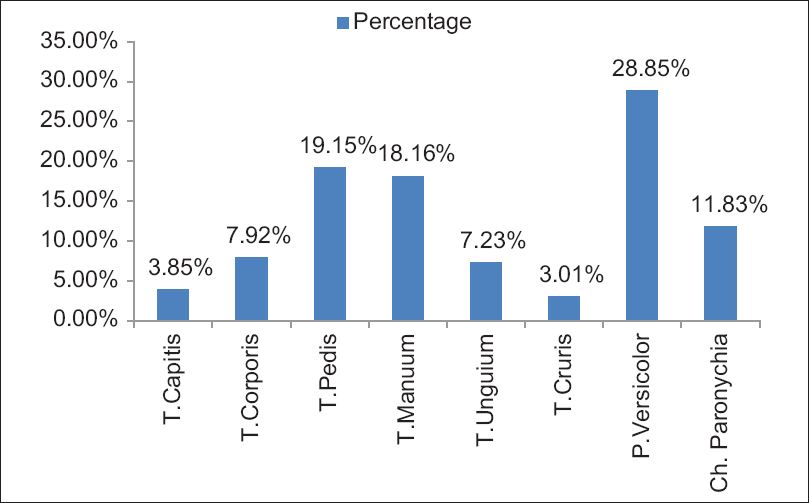 |
| Figure 2: Fungal infections |
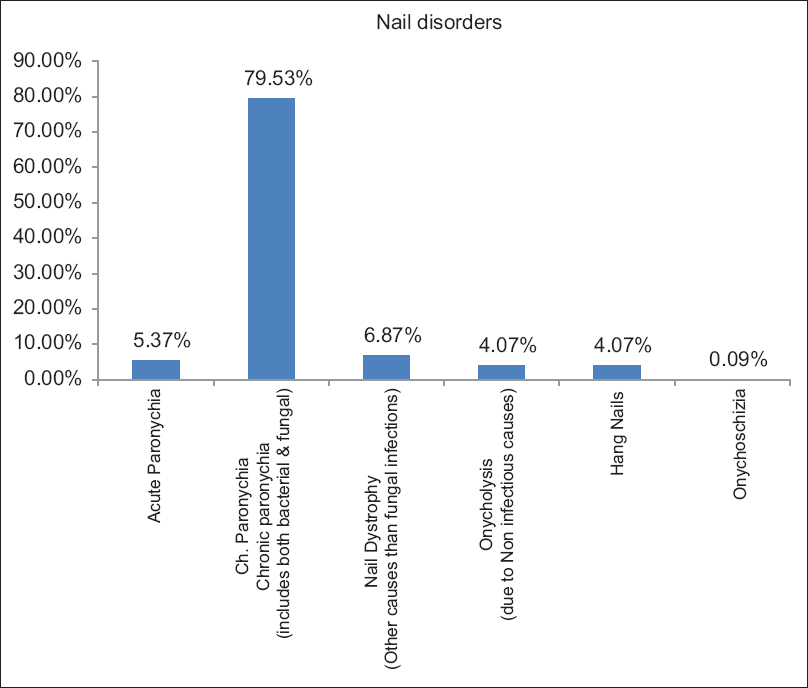 |
| Figure 3: Spectrum of nail disorders |
[Figure - 4] shows prevalence of viral infections; viral warts (75.10%, n = 15984) were the largest condition in this group though not included in this figure are detailed in [Table - 4].
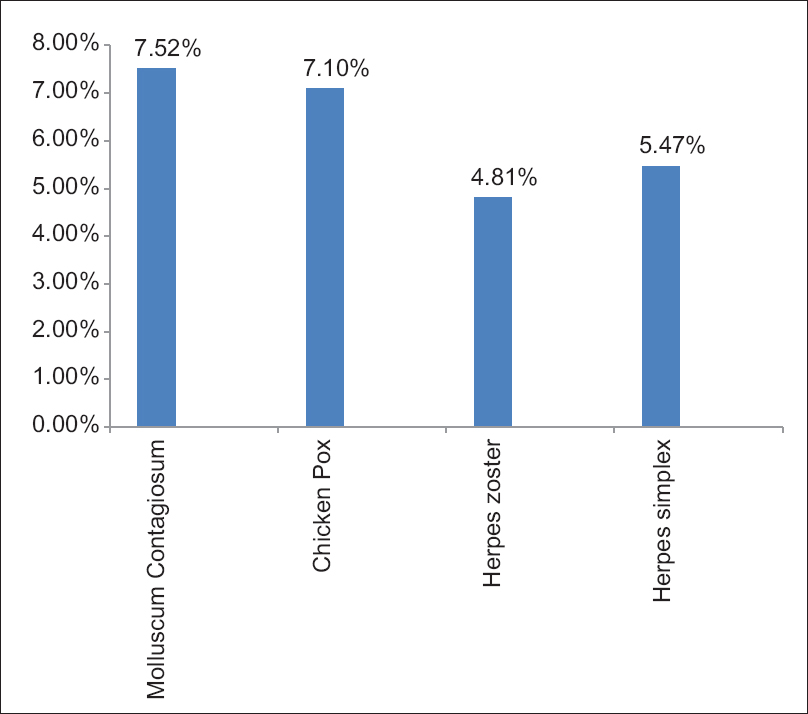 |
| Figure 4: Viral infections |
[Table - 5] depicts some important disorders that are classified in “Other dermatitis” according to International classification of diseases (ICD 10).
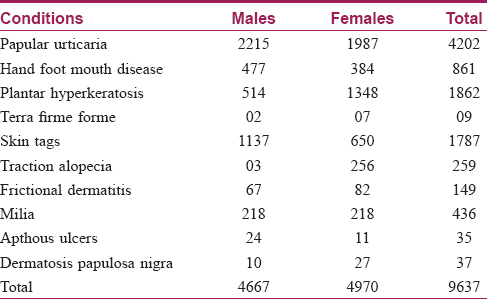
Zoman[1]et al also performed a similar study collecting 5 years' data from a tertiary care hospital in Saudi Arabia. However, our study includes cases from both primary care (walk-in) and secondary care (referred cases) setting; thus our study sample better showcases the true prevalence in general population. This minimizes selection bias among the subjects and could be extrapolated to reflect the trends in the whole country.
Infections were the commonest conditions in studies from Tunisia[2], Iran[3] and Qatar[4]. In the present study, a prevalence of 9.6% of fungal infections was noted and was followed by viral and bacterial infections. Hot and humid conditions in Oman almost throughout the year may be the predisposing factor for the high prevalence of fungal infections.
Prevalence of warts in our study was 6.88% which is comparable to another report (6.27%).[2] Details of viral infections are shown in [Figure - 4].
Bacterial infections were not very common (3.11%) in this study, they are shown in [Figure - 5].
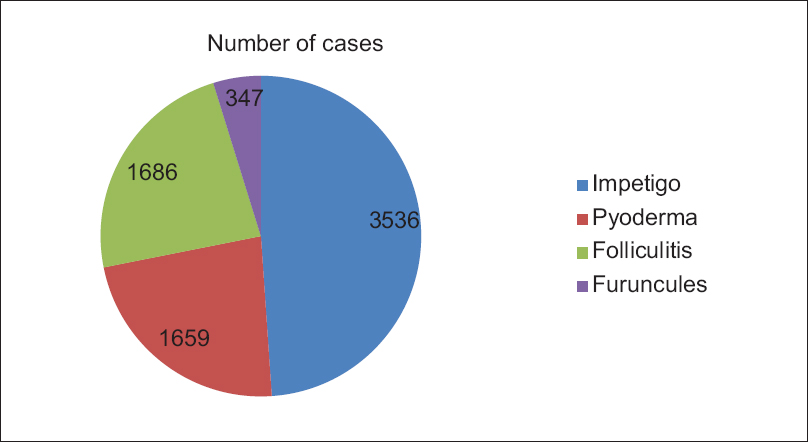 |
| Figure 5: Bacterial infections |
[Figure - 6] details various hair disorders observed in our study. Notwithstanding high ambient temperature throughout the year, high humidity and intense sun rays, the prevalence rates of miliaria were surprisingly low (0.61%). Air-conditioning facilities and a relaxed work culture may be the plausible explanation for the low prevalence. Other workers[2],[4] had also reported similar prevalence rates.
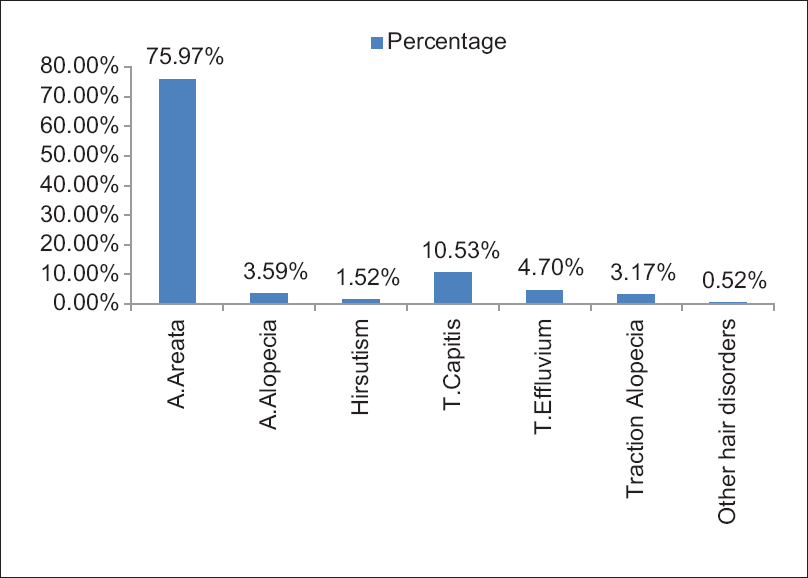 |
| Figure 6: Hair disorders |
Urticaria accounted for 4.1% of the cases in our study, similar to a report from Qatar,[4] while other investigators from the region had noted less prevalence.[1],[2]
Apart from a study on the prevalence of atopic dermatitis among school children in Oman,[5] there are no in-depth studies vis a vis skin diseases. The findings of this study however may not be applicable to populations from other countries due to varying ethnicity and geographic conditions. We have included both the walk-in as well as referred cases, hence the numbers may have increased due to duplication in some cases. Also, our population does not exclusively represent cases from north Batinah as it consisted a mix of the native as well as the local migrant population which was employed there.
This study provides an important insight into the spectrum and prevalence of cutaneous conditions in patients attending dermatology clinics in north Batinah governorate of Oman. It represents a diverse mix of people and the results may reflect countrywide prevalence. It will provide a basic framework and will contribute to better understanding of the patient care delivery needs and improved health care planning in the country.
Financial support and sponsorship
Nil.
Conflicts of interest
There are no conflicts of interest.
| 1. |
Al-Zoman AY, Facharizt, Al-Asmari AK. Pattern of skin diseases at Riyadh Military Hospital. Egypt Dermatol Online J. 2008;4(2):1-10. Available at http://www.edoj.org.eg/vol004/0402/004/01.htm. [Last accessed on 2017 May 28].
[Google Scholar]
|
| 2. |
A. Souissi, F. Zeglaoui, B. Zouari, M.R. Kamoun. A study of skin diseases in Tunis: an analysis of 28,244 dermatological outpatient cases. Acta Dermatovenerol Alp Panonica Adriat, 16 (2007), pp. 111–116.
[Google Scholar]
|
| 3. |
Baghestani S, Zare S, Mahboob AA. Skin disease pattern in Hormozgan, Iran. Int J Dermatol. 2005; 44: 641-5. PMID: 16101863.
[Google Scholar]
|
| 4. |
Al Abdulla HA, Selim MM, Kamal AM and Mansour K. Pattern of Skin Diseases in Qatar A Pilot Study. The Gulf J Dermatol. 1995;2:1:1-13. Al Samarai AG. Prevalence of skin diseases in Iraq: A community based study. Int J Dermatol. 2009; 48:734-9. PMID: 19570080.
[Google Scholar]
|
| 5. |
Al Riyami BM, Al Rawas OA, Al Riyami AA, Jasim LG, Mohammed AJ. A relatively high prevalence and severity of asthma, allergic rhinitis and atopic eczema in school children in the Sultanate of Oman. Respirology 2003.8 (1):69-76. PMID: 12856745
[Google Scholar]
|
Fulltext Views
4,342
PDF downloads
2,591





